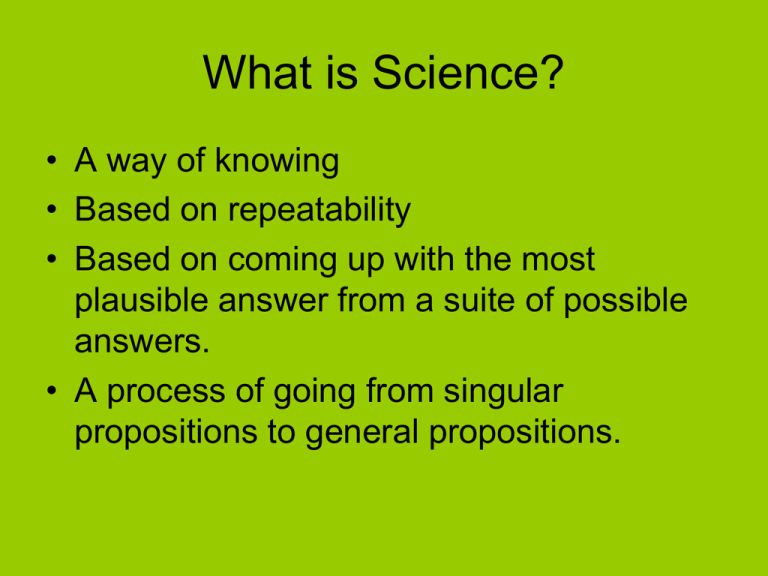
What is Science?
• A way of knowing
• Based on repeatability
• Based on coming up with the most
plausible answer from a suite of possible
answers.
• A process of going from singular
propositions to general propositions.
General Proposition
Theory
Law
Rule
Model
Hypothesis
Auxiliary Hypothesis
Ad hoc Hypothesis
Working Hypothesis
Singular proposition
Fact
Important concept.
• How many ways can two things be
identical?
• How many ways can two things be
different?
Justificationism
Falsificationism
The Process of Science
•
•
•
•
Observation –
Question – (Induction)
Logic – if ... then... (Deduction)
Hypothesis – H0 (no difference between observed and
expected) and H1 (observed and expected are different)
• Experiment –
• Result – reject or accept hypothesis
• alternative hypotheses
• Remember proof in science is impossible
Where does the genetic
information reside?
Discovery of chromosomes and DNA
• karyotype
-DNA discovered in 1869 by Friedrich Miescher, a
German Chemist. Extracted from the nucleus.
-Walther Flemming described the chromosomes in 1882
But this is not evidence that genes are
on chromosomes?
Observations:
Do both parents contribute equally to
offspring?
• What can we observe?
– Casual observations—children often resemble
parents, sometimes their mother, other times their
father
– Controlled crosses—when the same cross is set up
twice, switching the sex of the parent, the results
are the same.
What is in a typical egg? What is in a
typical sperm?
• Eggs
• Sperm
• genetic information -> CHROMOSOMES
One egg, many sperm
Griffith 1928 Streptococcus pneumoniae
• The ‘transforming principle’ of Griffith, using
‘Rough’ and ‘Smooth’ bacteria in 1928
R strain
S strain
Hammerling Exp
.
Hershey-Chase Experiment
The Science behind the discovery that the genetic material
resides in the chromosomes
• Observation – offspring inherit traits from their parents.
• Question – where does the information reside
responsible for traits?
• Observation - the nucleus appears to be important.
• Logic – if we remove the nucleus from a cell it will not
divide and grow
• Hypothesis – the nucleus contains the hereditary
information
• Null Hypothesis – Removal of the nucleus from a cell
will not affect development
• Experiment – remove or kill nucleus
• Result – cell does not develop – reject null hypothesis.
Timeline
• 1857 - Darwin - Characteristics of parents passed on
to young.
• 1869 – Friedrich Miescher – discovered ‘nuclein’
(DNA)
• 1882 – Walther Flemming – Chromosomes
• 1928 – Griffith – transforming principle
• 1930’s – Hammerling – Acetabularia nucleus
• 1952 – Hershey-Chase Experiment
• 1952 – Briggs and King – nuclear transplant exp. in
frogs








